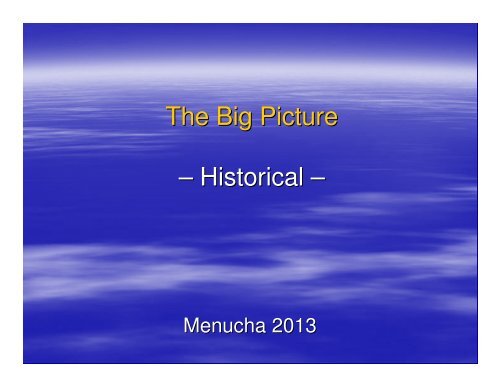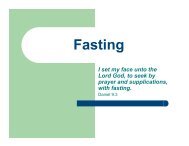Slides - Western Christadelphian Bible School
Slides - Western Christadelphian Bible School
Slides - Western Christadelphian Bible School
Create successful ePaper yourself
Turn your PDF publications into a flip-book with our unique Google optimized e-Paper software.
The Big Picture<br />
– Historical –<br />
Menucha 2013
Tyranny<br />
Cain<br />
Nimrod<br />
Egyptians<br />
Sennacherib<br />
Nebuchadnezzar<br />
Alexander<br />
Caesars
Animals, or Man?
Zechariah 9<br />
Bucephalus
The Historicity of Jesus<br />
Jesus and the Historian<br />
“But, above all, if we apply to the New Testament, as we should,<br />
the same sort of criteria as we should apply to other ancient<br />
writings containing historical material, we can no more reject<br />
Jesus’ existence than we can reject the existence of a mass of<br />
pagan personages whose reality as historical figures is never<br />
questioned.”<br />
Historian Michael Grant<br />
Michael Grant, Jesus: An Historian’s s Review of the Gospels (New<br />
York:<br />
Charles Scribner’s Sons, 1977), pp. 199-200.
The Reliability of the<br />
New Testament Versus Shakespeare<br />
“It seems strange that the text of Shakespeare, which has been in existence less than<br />
two hundred and eight years, should be far more uncertain and corrupt than that of the<br />
New Testament, now over eighteen centuries old, during the nearly y fifteen of which it<br />
existed only in manuscript....With perhaps a dozen or twenty exceptions, eptions, the text of<br />
every verse in the New Testament may be said to be so far settled d by general consent of<br />
scholars, that any dispute as to its readings must relate rather to the interpretation of the<br />
words than to any doubts respecting the words themselves. But in every one of<br />
Shakespeare’s s thirty-seven plays there are probably a hundred readings still in dispute,<br />
a large portion of which materially affects the meaning of the passages p<br />
in which they<br />
occur.”<br />
A literary review cited by John W. Lea, The Greatest Book in the World (Philadelphia,<br />
PA: n.p., 1929), p. 15.
The Resurrection of Jesus:<br />
No Controvertible Evidence Exists<br />
“Accordingly, if all the evidence is weighed carefully and fairly, , it is indeed<br />
justifiable, according to the canons of historical research, to conclude that<br />
the tomb in which Jesus was buried was actually empty on the morning of<br />
the first Easter. And no shred of evidence has yet been discovered in<br />
literary sources, epigraphy or archaeology that would disprove this t<br />
statement.”<br />
Dr. Paul L. Maier, professor of ancient history at <strong>Western</strong> Michigan<br />
University<br />
Paul L. Maier, In The Fullness of Time: A Historian Looks at Christmas,<br />
Easter, and The Early Church (Grand Rapids, MI:<br />
Kregel Publications, 1991/1997), p. 203.
Proofs of the Resurrection of Jesus<br />
•Historical reliability of the burial account supports the empty tomb<br />
•Gospel accounts of resurrection are reliable in two respects:<br />
•eyewitnesses are mentioned by name; therefore, not fictionalized characters but real<br />
people<br />
•written within generation of occurrence<br />
•Preaching would have been silenced if tomb wasn’t t empty or body or Jesus was<br />
produced<br />
•Earliest Jewish propaganda against Christians presupposes empty tomb<br />
•That Jesus’ tomb was not venerated as a shrine indicates that the tomb was empty<br />
•Appearance of Jesus to all his disciples<br />
•Appearance of Jesus to 500<br />
•Appearance of Jesus to his brother James<br />
•Change in Jesus’ family (Galatians 1:19; 1 Corinthians 9:5 cp. Mark 3:21, 31-35;<br />
35;<br />
John 7:1-10)<br />
10)
1 Corinthians 15:6 -- 500 Witnesses<br />
•11 Corinthians is generally believed to have been written in A.D. 55<br />
•William Lillie, head of the Department of Biblical Study at the University of<br />
Aberdeen, notes:<br />
“What gives a special authority to the list as historical evidence e is the reference to<br />
most of the five hundred brethren being still alive. St. Paul says s<br />
in effect, ‘If you do<br />
not believe me, you can ask them.’ Such a statement in an admittedly genuine<br />
letter written within thirty years of the event is almost as strong evidence as one<br />
could hope to get for something that happened nearly two thousand d years ago.”<br />
William Lillie, “The Empty Tomb and the Resurrection,” in D.E. Nineham et al.,<br />
Historicity and Chronology in the New Testament (1965), p. 125.
Proofs of the Resurrection of Jesus<br />
•Change in disciples’ behaviour and disposition<br />
•Improbable that 11 men would give up pursuit of<br />
happiness to lead life of poverty and persecution<br />
•Disciples could not have stolen the body even if<br />
they wanted to<br />
Without resurrection, nothing else reasonably<br />
accounts for the early growth of Christianity in the<br />
heart of Israel and its persistence in spite of severe<br />
persecution
John 20:24-31







